
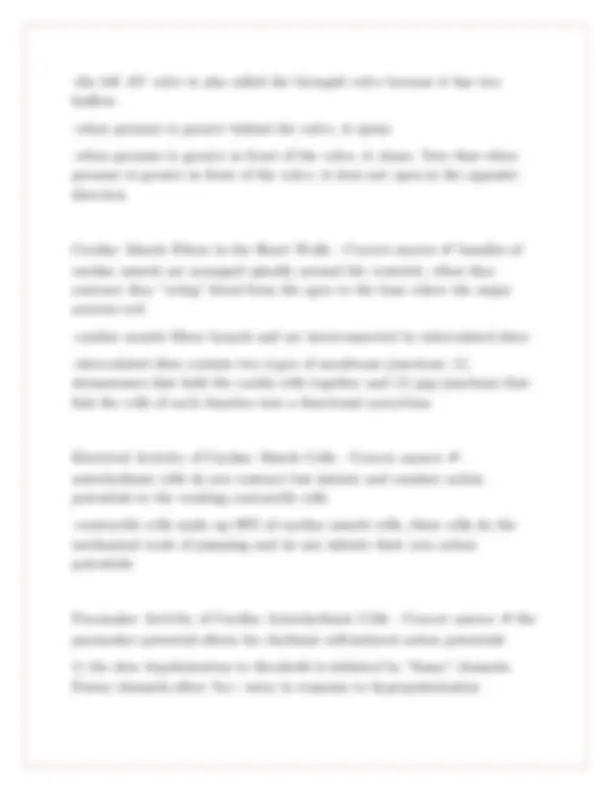
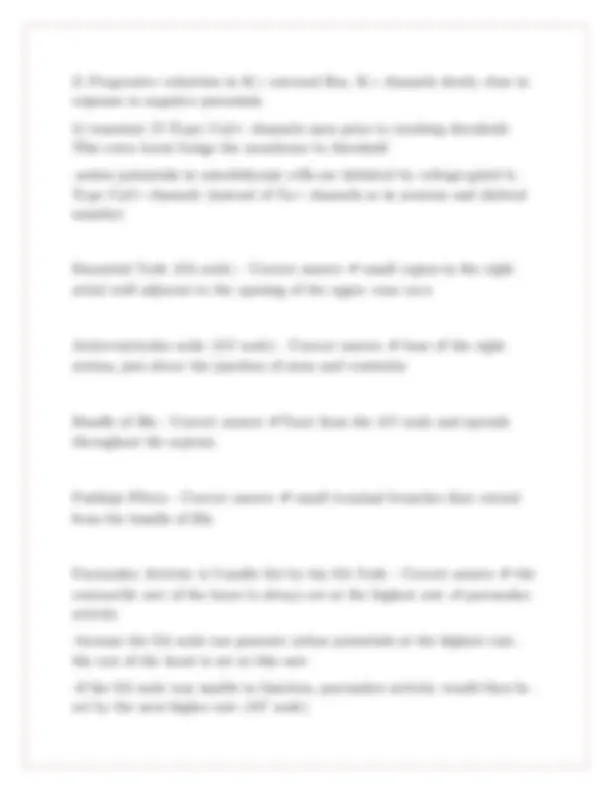
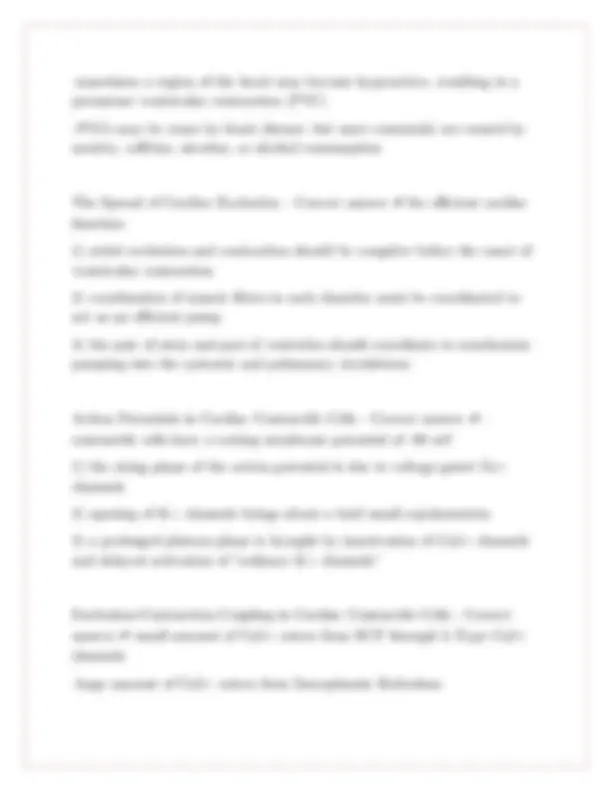


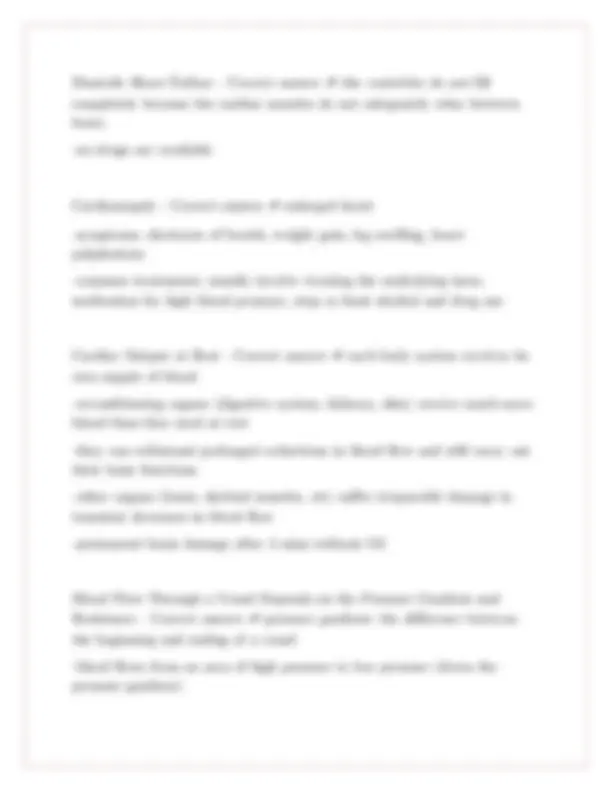

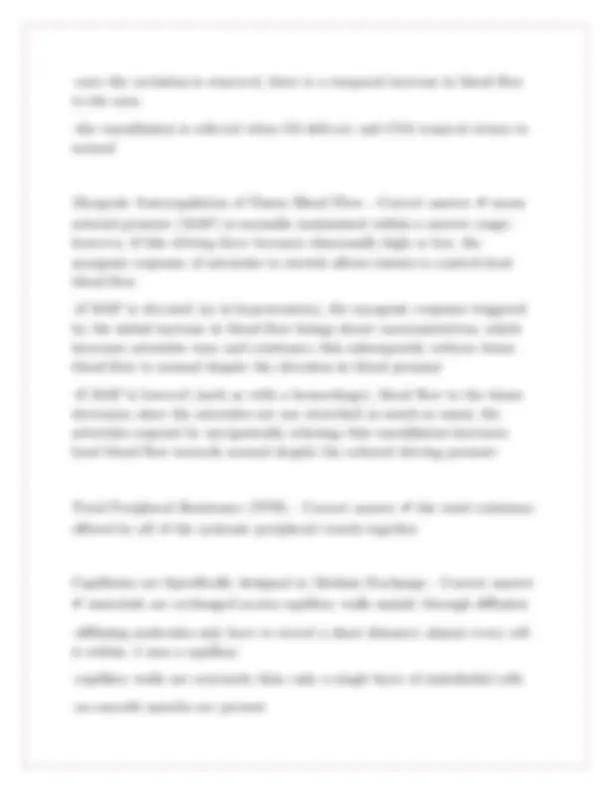

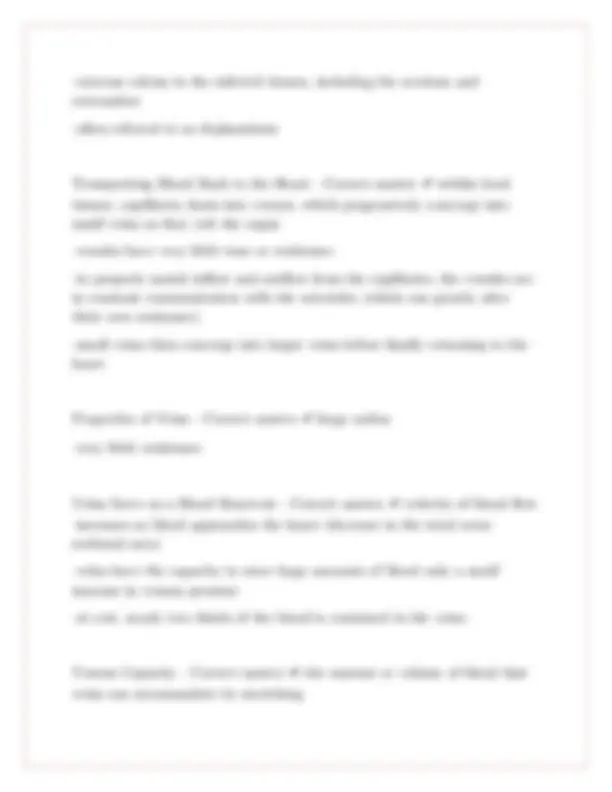

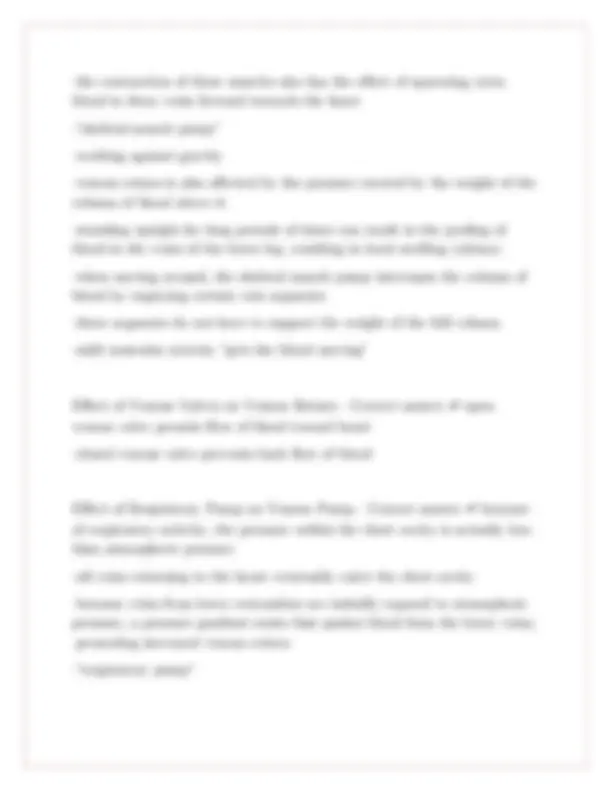
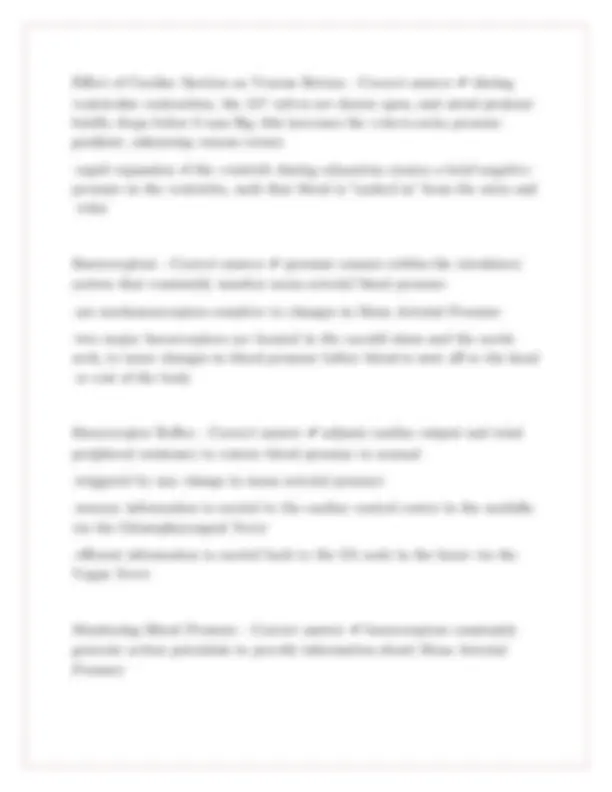

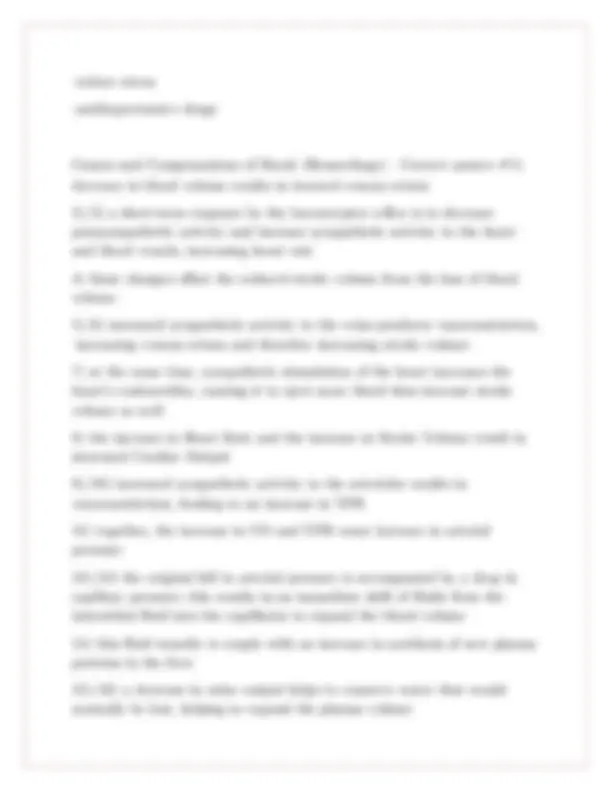
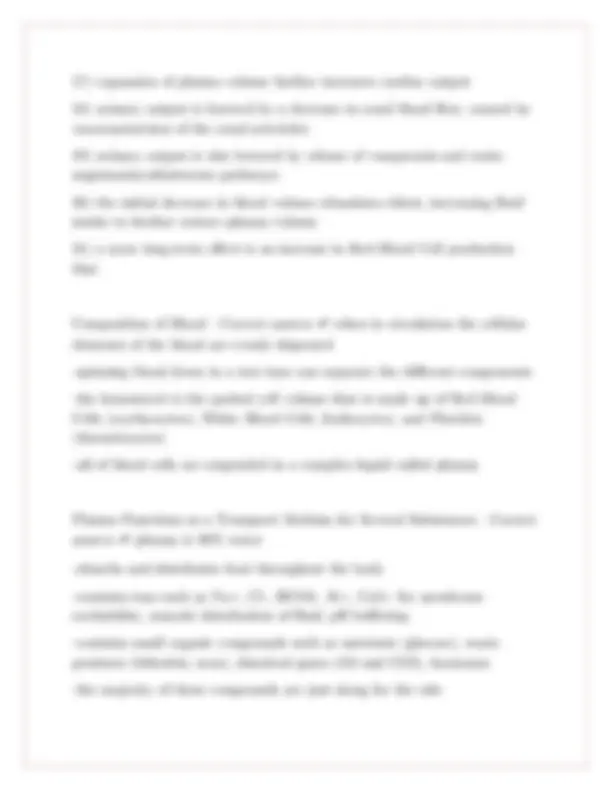

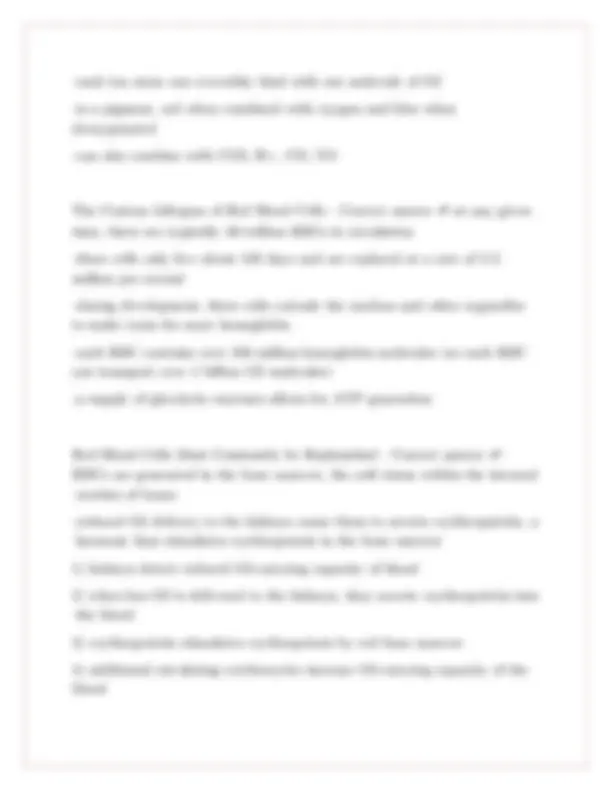
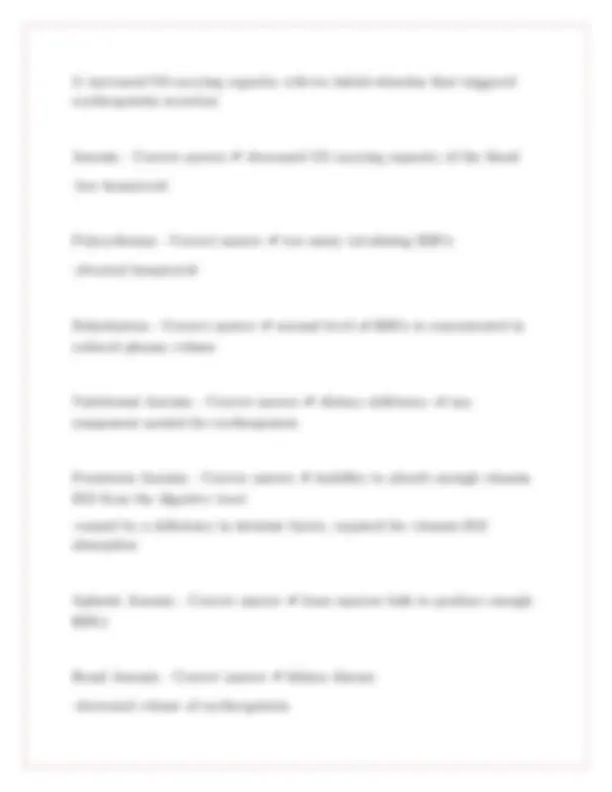
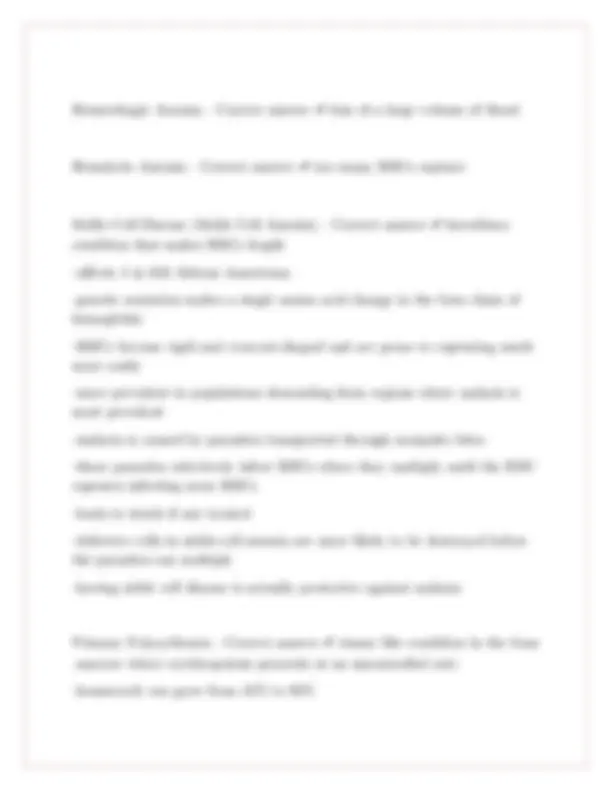


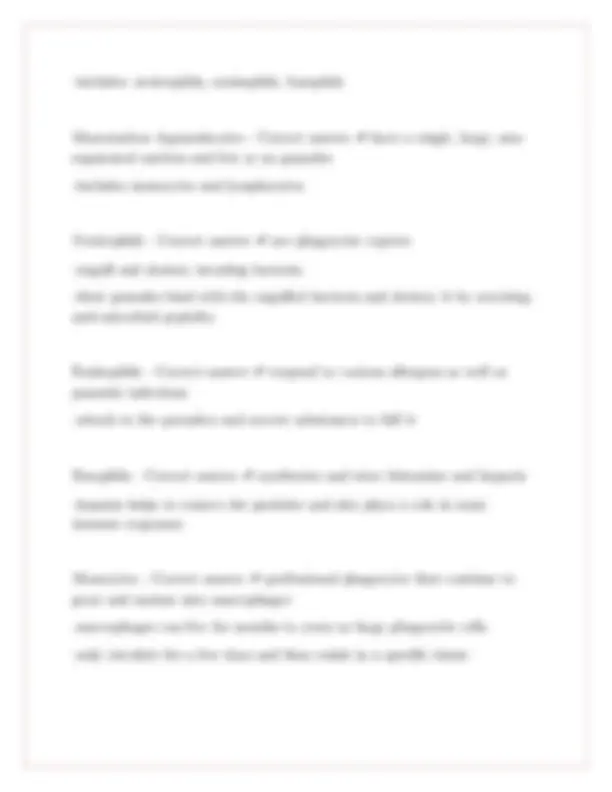
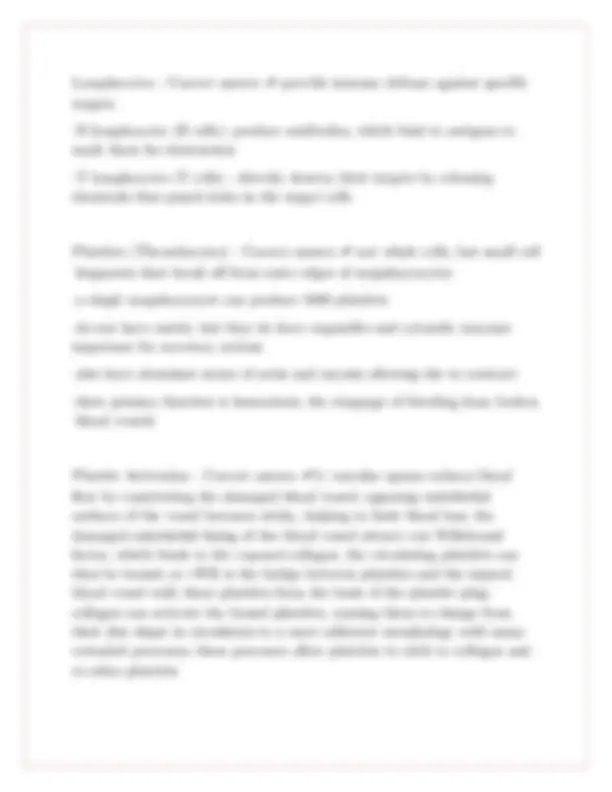


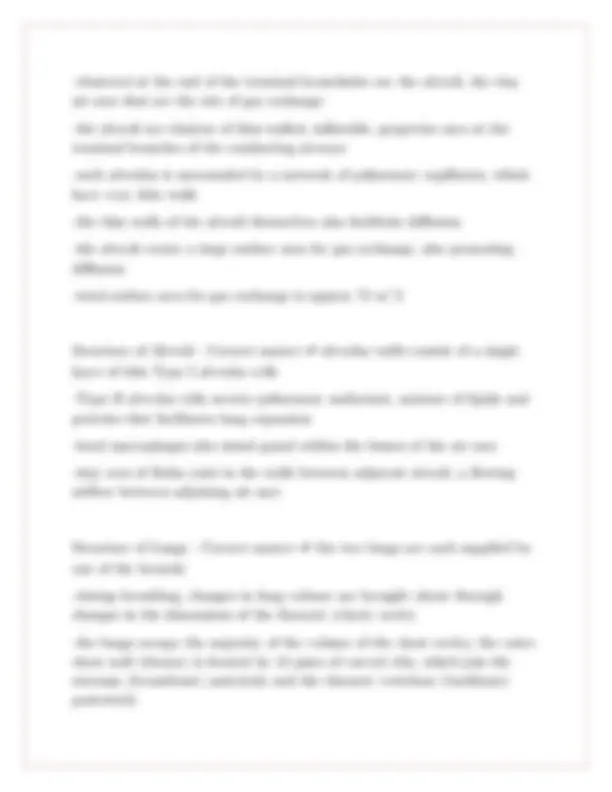



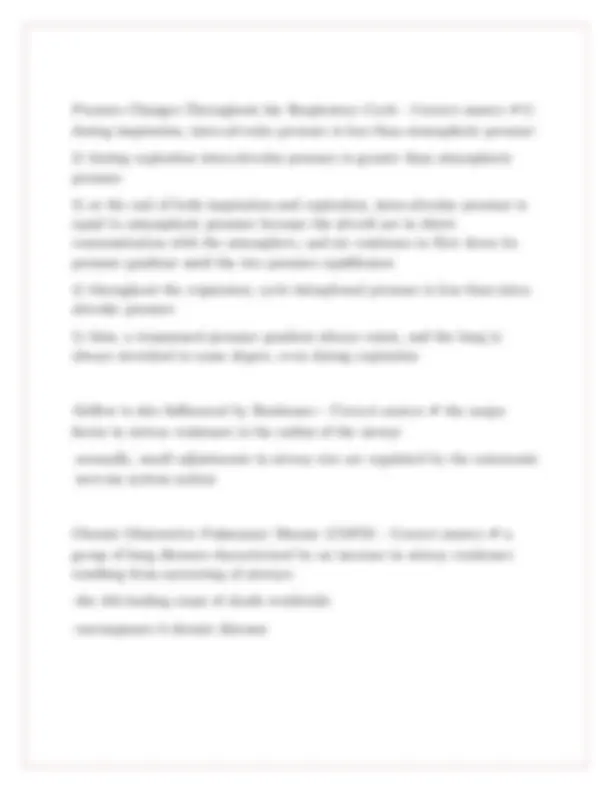
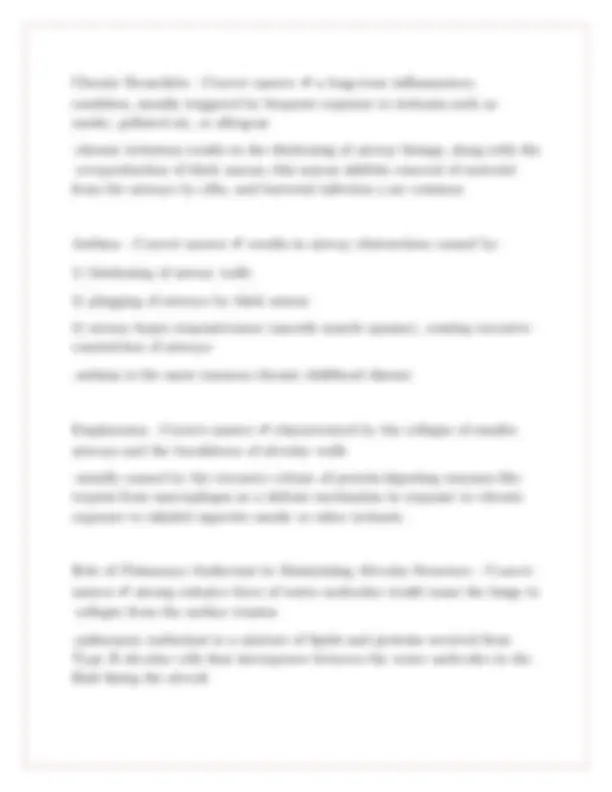


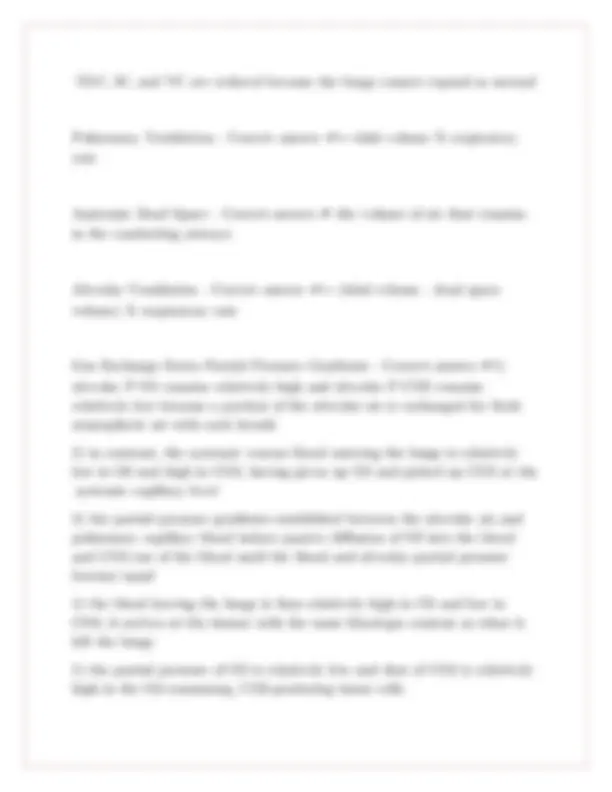
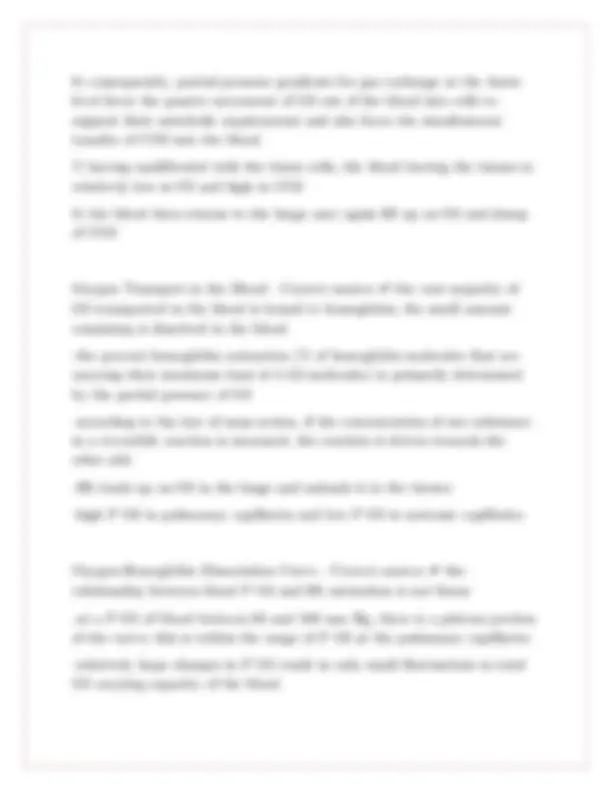
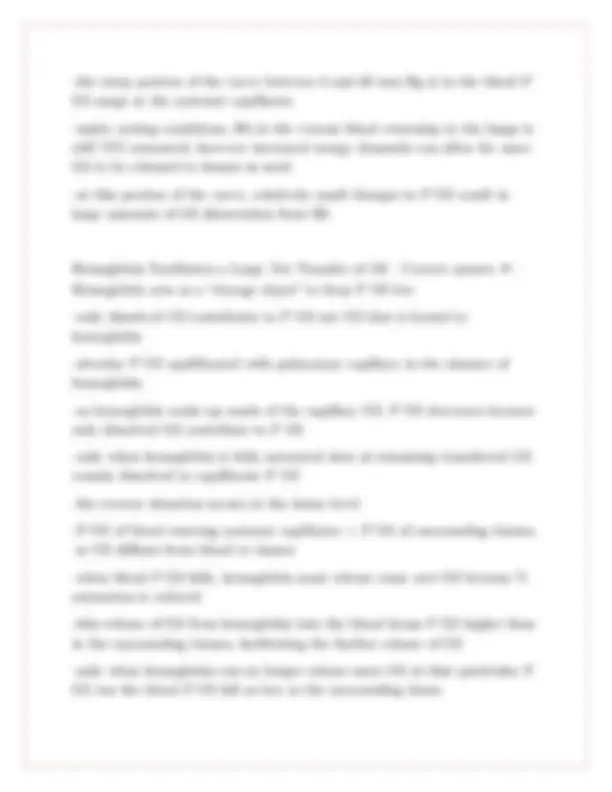
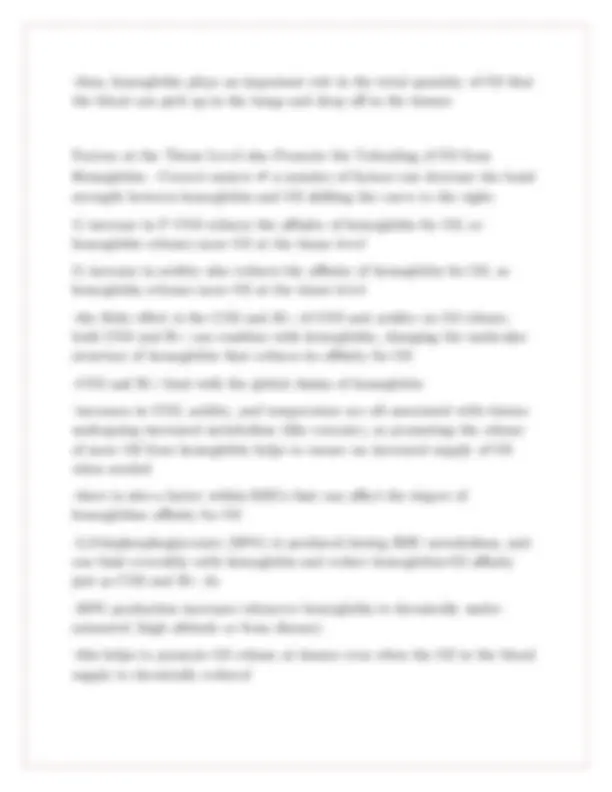



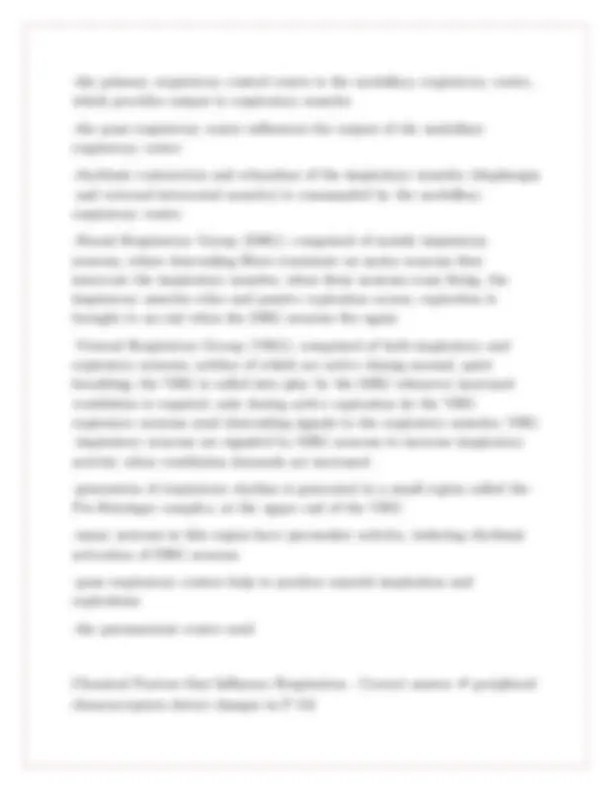
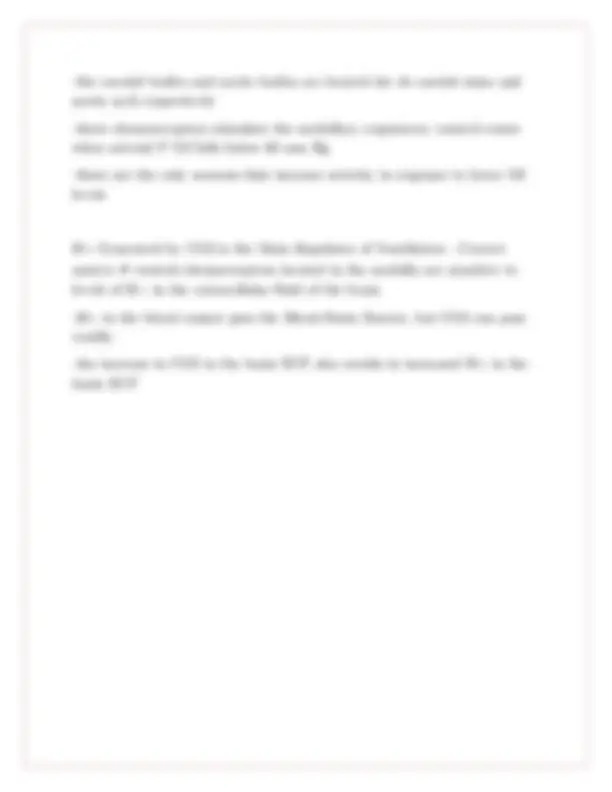


Study with the several resources on Docsity

Earn points by helping other students or get them with a premium plan


Prepare for your exams
Study with the several resources on Docsity

Earn points to download
Earn points by helping other students or get them with a premium plan
Community
Ask the community for help and clear up your study doubts
Discover the best universities in your country according to Docsity users
Free resources
Download our free guides on studying techniques, anxiety management strategies, and thesis advice from Docsity tutors
BIOS 235 BIO 235 Exam 3 with precise detailed answers
Typology: Exams
1 / 51

This page cannot be seen from the preview
Don't miss anything!












































Pulmonary |! Circulation |! - |! Correct |! answer |! ✔-carries |! blood |! between |! the |! heart |! and |! lungs |! -simultaneously |! loops |! through |! both |! the |! left |! and |! right |! lungs |! -low-pressure, |! low-resistance |! system Systemic |! Circulation |! - |! Correct |! answer |! ✔-carries |! blood |! between |! the |! heart |! and |! all |! of |! the |! remaining |! body |! systems |! -simultaneously |! loops |! through |! both |! the |! upper |! and |! lower |! halves |! of |! the |! body |! -high-pressure, |! high-resistance |! system The |! Heart |! Consist |! of |! Four |! Chambers |! - |! Correct |! answer |! ✔-the |! left |! and |! right |! atria |! (atrium) |! receive |! blood |! that |! is |! traveling |! back |! to |! the |! heart |! and |! transfer |! it |! to |! the |! left |! and |! right |! ventricles |! (respectively), |! which |! pump |! blood |! from |! the |! heart Veins |! - |! Correct |! answer |! ✔-blood |! vessels |! that |! carry |! blood |! from |! other |! tissues |! to |! the |! atria Arteries |! - |! Correct |! answer |! ✔-blood |! vessels |! that |! carry |! blood |! away |! from |! the |! ventricles
Septum |! - |! Correct |! answer |! ✔-separates |! the |! left |! and |! right |! sides |! of |! the |! heart |! -a |! muscular |! structure |! that |! prevents |! mixing |! of |! O2-rich |! and |! O2-poor |! blood Following |! a |! drop |! of |! blood |! through |! the |! complete |! circuit |! - |! Correct |! answer |! ✔-blood |! returning |! from |! systemic |! circulation |! enters |! the |! right |! atrium |! via |! two |! large |! veins: |! the |! vena |! cava -this |! blood |! travels |! from |! the |! right |! atrium |! to |! the |! right |! ventricle, |! where |! it |! is |! then |! pumped |! out |! through |! the |! pulmonary |! artery |! (two |! branches, |! one |! for |! each |! lung, |! left |! and |! right |! arteries) |! -in |! the |! lungs, |! this |! blood |! picks |! up |! a |! fresh |! supply |! of |! O2 |! and |! returns |! to |! the |! left |! atrium |! via |! the |! pulmonary |! veins |! -blood |! travels |! from |! the |! left |! atrium |! to |! the |! left |! ventricle, |! where |! it |! is |! pumped |! out |! into |! systemic |! circulation |! via |! the |! aorta Comparison |! of |! the |! Left |! and |! Right |! Pumps |! - |! Correct |! answer |! ✔-both |! sides |! of |! the |! heart |! pump |! the |! same |! amount |! of |! blood |! at |! the |! same |! time |! -the |! left |! side |! of |! the |! heart |! has |! to |! work |! harder |! because |! it |! is |! responsible |! for |! pumping |! equal |! amount |! of |! blood |! at |! a |! higher |! pressure |! against |! a |! higher |! resistance |! in |! a |! longer |! system; |! because |! of |! this, |! the |! heart |! muscle |! on |! the |! right |! side |! is |! thicker, |! making |! is |! a |! stronger |! pump Pressure-Operated |! Valves |! Ensure |! Unidirectional |! Blood |! Flow |! - |! Correct |! answer |! ✔-the |! right |! and |! left |! Atrioventricular |! (AV) |! valves |! separate |! the |! atria |! from |! the |! ventricles |! on |! each |! side |! -the |! right |! AV |! valve |! is |! also |! called |! the |! tricuspid |! valve |! because |! it |! has |! three |! leaflets |!
-sometimes |! a |! region |! of |! the |! heart |! may |! become |! hyperactive, |! resulting |! in |! a |! premature |! ventricular |! contraction |! (PVC) |! -PVCs |! may |! be |! cause |! by |! heart |! disease, |! but |! more |! commonly |! are |! caused |! by |! anxiety, |! caffeine, |! nicotine, |! or |! alcohol |! consumption The |! Spread |! of |! Cardiac |! Excitation |! - |! Correct |! answer |! ✔-for |! efficient |! cardiac |! function: |!
Atrial |! Flutter |! - |! Correct |! answer |! ✔-atrial |! depolarization |! rates |! of |! 200-380 |! beats |! per |! minute, |! followed |! by |! high |! ventricular |! rate |! that |! prevents |! ventricular |! filling |! between |! beats Atrial |! Fibrillation |! - |! Correct |! answer |! ✔-irregular |! uncoordinated |! atrial |! depolarization, |! QRS |! complexes |! are |! normal |! in |! shape |! but |! occur |! sporadically Ventricular |! Fibrillation |! - |! Correct |! answer |! ✔-multiple |! impulses |! travel |! erratically |! in |! all |! directions, |! irregular |! ECG |! pattern |! with |! no |! detectable |! waveforms Complete |! Heart |! Block |! - |! Correct |! answer |! ✔-dissociation |! between |! atrial |! and |! ventricular |! contractions Acute |! Myocardial |! Infarction |! (heart |! attack) |! - |! Correct |! answer |! ✔-death |! of |! muscle |! cells |! occurs |! whenever |! a |! blood |! vessel |! supplying |! a |! particular |! area |! of |! the |! hear |! becomes |! blocked |! or |! ruptured Events |! of |! the |! Cardiac |! Cycle |! (Wiggers |! Diagram) |! - |! Correct |! answer |! ✔-the |! cardiac |! cycle |! consists |! fo |! alternate |! periods |! of |! systole |! (contraction |! and |! emptying) |! and |! diastole |! (relaxation |! and |! filling) |! -phase |! corresponds |! to |! TP |! segment |! on |! ECG |!
Diastolic |! Heart |! Failure |! - |! Correct |! answer |! ✔-the |! ventricles |! do |! not |! fill |! completely |! because |! the |! cardiac |! muscles |! do |! not |! adequately |! relax |! between |! beats -no |! drugs |! are |! available Cardiomegaly |! - |! Correct |! answer |! ✔-enlarged |! heart |! -symptoms: |! shortness |! of |! breath, |! weight |! gain, |! leg |! swelling, |! heart |! palpitations |! -common |! treatments: |! usually |! involve |! treating |! the |! underlying |! issue, |! medication |! for |! high |! blood |! pressure, |! stop |! or |! limit |! alcohol |! and |! drug |! use Cardiac |! Output |! at |! Rest |! - |! Correct |! answer |! ✔-each |! body |! system |! receives |! its |! own |! supply |! of |! blood -reconditioning |! organs |! (digestive |! system, |! kidneys, |! skin) |! receive |! much |! more |! blood |! than |! they |! need |! at |! rest |! -they |! can |! withstand |! prolonged |! reductions |! in |! blood |! flow |! and |! still |! carry |! out |! their |! basic |! functions |! -other |! organs |! (brain, |! skeletal |! muscles, |! etc) |! suffer |! irreparable |! damage |! in |! transient |! decreases |! in |! blood |! flow -permanent |! brain |! damage |! after |! 4 |! mins |! without |! O Blood |! Flow |! Through |! a |! Vessel |! Depends |! on |! the |! Pressure |! Gradient |! and |! Resistance |! - |! Correct |! answer |! ✔-pressure |! gradient: |! the |! difference |! between |! the |! beginning |! and |! ending |! of |! a |! vessel -blood |! flows |! from |! an |! area |! of |! high |! pressure |! to |! low |! pressure |! (down |! the |! pressure |! gradient) |!
-resistance: |! the |! opposition |! of |! blood |! flow |! caused |! by |! friction |! between |! the |! fluid |! and |! the |! vascular |! walls Blood |! Flow |! Resistance |! and |! the |! Effect |! of |! Vessel |! Radius |! - |! Correct |! answer |! ✔- the |! major |! determinant |! of |! resistance |! to |! blood |! flow |! is |! the |! radius |! of |! the |! vessel |! -a |! slight |! change |! in |! the |! radius |! of |! a |! vessel |! brings |! about |! substantial |! change |! in |! blood |! flow Arteries |! - |! Correct |! answer |! ✔-carry |! blood |! from |! the |! heart |! to |! the |! various |! organs -they |! branch |! off |! into |! smaller |! vessels Arterioles |! - |! Correct |! answer |! ✔-when |! an |! artery |! reaches |! an |! organ |! and |! branches |! down |! further Capillaries |! - |! Correct |! answer |! ✔-arterioles |! branch |! further |! into |! these -are |! the |! smallest |! vessels |! and |! primary |! site |! of |! exchange |! with |! organs |! -capillary |! exchange |! is |! the |! entire |! purpose |! of |! the |! circulatory |! system Venules |! - |! Correct |! answer |! ✔-capillaries |! rejoin |! to |! form |! these Microcirculation |! - |! Correct |! answer |! ✔-components |! only |! visible |! under |! the |! microscope -arterioles, |! capillaries, |! venules
Arterioles |! are |! the |! Major |! Resistance |! Vessels |! - |! Correct |! answer |! ✔-arteriolar |! smooth |! muscle |! is |! normally |! in |! a |! state |! of |! partial |! constriction |! called |! vascular |! tone |! -this |! establishes |! a |! baseline |! arteriolar |! resistance -because |! of |! vascular |! tone, |! arterioles |! can |! increase |! or |! decrease |! their |! diameter |! to |! meed |! specific |! needs Active |! Hyperemia |! - |! Correct |! answer |! ✔-increased |! blood |! flow |! to |! a |! particular |! tissue |! in |! response |! to |! enhanced |! tissue |! activity |! -when |! cells |! are |! more |! metabolically |! active, |! they |! need |! more |! blood |! to |! bring |! in |! more |! O2 |! and |! nutrients |! and |! to |! remove |! metabolic |! waste -arterioles |! lie |! within |! the |! tissue |! they |! supply -metabolic |! activity |! of |! the |! local |! tissue |! can |! alter |! blood |! flow |! by |! adjusting |! arteriolar |! radius -local |! metabolic |! changes |! (such |! as |! decreased |! O2 |! levels |! in |! skeletal |! muscles |! during |! exercise) |! can |! signal |! the |! need |! for |! additional |! blood |! flow Reactive |! Hyperemia |! - |! Correct |! answer |! ✔-when |! the |! blood |! supply |! to |! a |! particular |! region |! is |! completely |! occluded |! (such |! as |! with |! a |! tourniquet), |! many |! of |! the |! same |! chemical |! changes |! occur |! in |! this |! region |! that |! occur |! during |! active |! hyperemia -ex: |! lower |! O2 |! levels |! -the |! imbalance |! occurs |! because |! blood |! flow |! decreases |! while |! metabolic |! activity |! remains |! constant |! -local |! arterioles |! vasodilate, |! but |! there |! is |! still |! no |! blood |! flow |! as |! long |! as |! the |! occlusion |! remains |!
-once |! the |! occlusion |! is |! removed, |! there |! is |! a |! temporal |! increase |! in |! blood |! flow |! to |! the |! area -the |! vasodilation |! is |! relieved |! when |! O2 |! delivery |! and |! CO2 |! removal |! return |! to |! normal Myogenic |! Autoregulation |! of |! Tissue |! Blood |! Flow |! - |! Correct |! answer |! ✔-mean |! arterial |! pressure |! (MAP) |! is |! normally |! maintained |! within |! a |! narrow |! range; |! however, |! if |! this |! driving |! force |! becomes |! abnormally |! high |! or |! low, |! the |! myogenic |! response |! of |! arterioles |! to |! stretch |! allows |! tissues |! to |! control |! local |! blood |! flow |! -if |! MAP |! is |! elevated |! (as |! in |! hypertension), |! the |! myogenic |! response |! triggered |! by |! the |! initial |! increase |! in |! blood |! flow |! brings |! about |! vasoconstriction, |! which |! increases |! arteriolar |! tone |! and |! resistance; |! this |! subsequently |! reduces |! tissue |! blood |! flow |! to |! normal |! despite |! the |! elevation |! in |! blood |! pressure |! -if |! MAP |! is |! lowered |! (such |! as |! with |! a |! hemorrhage), |! blood |! flow |! to |! the |! tissue |! decreases; |! since |! the |! arterioles |! are |! nor |! stretched |! as |! much |! as |! usual, |! the |! arterioles |! respond |! by |! myogenically |! relaxing; |! this |! vasodilation |! increases |! local |! blood |! flow |! towards |! normal |! despite |! the |! reduced |! driving |! pressure Total |! Peripheral |! Resistance |! (TPR) |! - |! Correct |! answer |! ✔-the |! total |! resistance |! offered |! by |! all |! of |! the |! systemic |! peripheral |! vessels |! together Capillaries |! are |! Specifically |! designed |! to |! Mediate |! Exchange |! - |! Correct |! answer |! ✔-materials |! are |! exchanged |! across |! capillary |! walls |! mainly |! through |! diffusion |! -diffusing |! molecules |! only |! have |! to |! travel |! a |! short |! distance; |! almost |! every |! cell |! is |! within |! .1 |! mm |! a |! capillary -capillary |! walls |! are |! extremely |! thin; |! only |! a |! single |! layer |! of |! endothelial |! cells |! -no |! smooth |! muscles |! are |! present |!
-almost |! all |! tissues |! have |! initial |! lymphatics |! imbedded |! within |! them, |! which |! merge |! into |! larger |! vessels |! before |! the |! interstitial |! fluid |! is |! drained |! back |! into |! the |! veins Lymphatic |! System |! - |! Correct |! answer |! ✔-important |! roles: |!
Venous |! Return |! - |! Correct |! answer |! ✔-the |! volume |! of |! blood |! per |! minute |! that |! enters |! each |! atrium |! from |! the |! veins Factors |! that |! Enhance |! Venous |! Return |! - |! Correct |! answer |! ✔-sympathetic |! activity |! -skeletal |! muscle |! pump -venous |! valves -respiratory |! pump -cardiac |! suction Effect |! of |! Sympathetic |! Activity |! on |! Venous |! Return |! - |! Correct |! answer |! ✔- venous |! smooth |! muscle |! has |! abundant |! sympathetic |! innervation |! -sympathetic |! stimulation |! produces |! venous |! vasoconstriction, |! elevating |! venous |! pressure |! and |! driving |! more |! stored |! blood |! out |! of |! the |! veins |! into |! the |! right |! atrium |! (increased |! venous |! return) |! -this |! modest |! vasoconstriction |! has |! little |! impact |! on |! resistance |! because |! the |! radius |! of |! most |! veins |! is |! so |! large -vasoconstriction |! has |! a |! very |! different |! effect |! in |! arterioles |! -vasoconstriction |! in |! arterioles |! leads |! to |! increased |! resistance |! and |! decreased |! flow |! through |! the |! vessel -vasoconstriction |! in |! veins |! immediately |! increases |! flow |! because |! of |! their |! decreased |! capacity |! (squeezing |! out |! more |! blood |! that |! is |! already |! in |! the |! veins) Effect |! of |! Skeletal |! Muscle |! Pump |! on |! Venous |! Return |! - |! Correct |! answer |! ✔- many |! veins |! in |! the |! extremities |! lie |! between |! large |! skeletal |! muscles |!
-the |! contraction |! of |! these |! muscles |! also |! has |! the |! effect |! of |! squeezing |! extra |! blood |! in |! these |! veins |! forward |! towards |! the |! heart |! -"skeletal |! muscle |! pump" |! -working |! against |! gravity -venous |! return |! is |! also |! affected |! by |! the |! pressure |! exerted |! by |! the |! weight |! of |! the |! column |! of |! blood |! above |! it |! -standing |! upright |! for |! long |! periods |! of |! times |! can |! result |! in |! the |! pooling |! of |! blood |! in |! the |! veins |! of |! the |! lower |! leg, |! resulting |! in |! local |! swelling |! (edema) |! -when |! moving |! around, |! the |! skeletal |! muscle |! pump |! interrupts |! the |! column |! of |! blood |! by |! emptying |! certain |! vein |! segments |! -these |! segments |! do |! not |! have |! to |! support |! the |! weight |! of |! the |! full |! column |! -mild |! muscular |! activity |! "gets |! the |! blood |! moving" Effect |! of |! Venous |! Valves |! on |! Venous |! Return |! - |! Correct |! answer |! ✔-open |! venous |! valve |! permits |! flow |! of |! blood |! toward |! heart -closed |! venous |! valve |! prevents |! back |! flow |! of |! blood Effect |! of |! Respiratory |! Pump |! on |! Venous |! Pump |! - |! Correct |! answer |! ✔-because |! of |! respiratory |! activity, |! the |! pressure |! within |! the |! chest |! cavity |! is |! actually |! less |! than |! atmospheric |! pressure |! -all |! veins |! returning |! to |! the |! heart |! eventually |! enter |! the |! chest |! cavity |! -because |! veins |! from |! lower |! extremities |! are |! initially |! exposed |! to |! atmospheric |! pressure, |! a |! pressure |! gradient |! exists |! that |! pushes |! blood |! form |! the |! lower |! veins, |! promoting |! increased |! venous |! return |! -"respiratory |! pump"